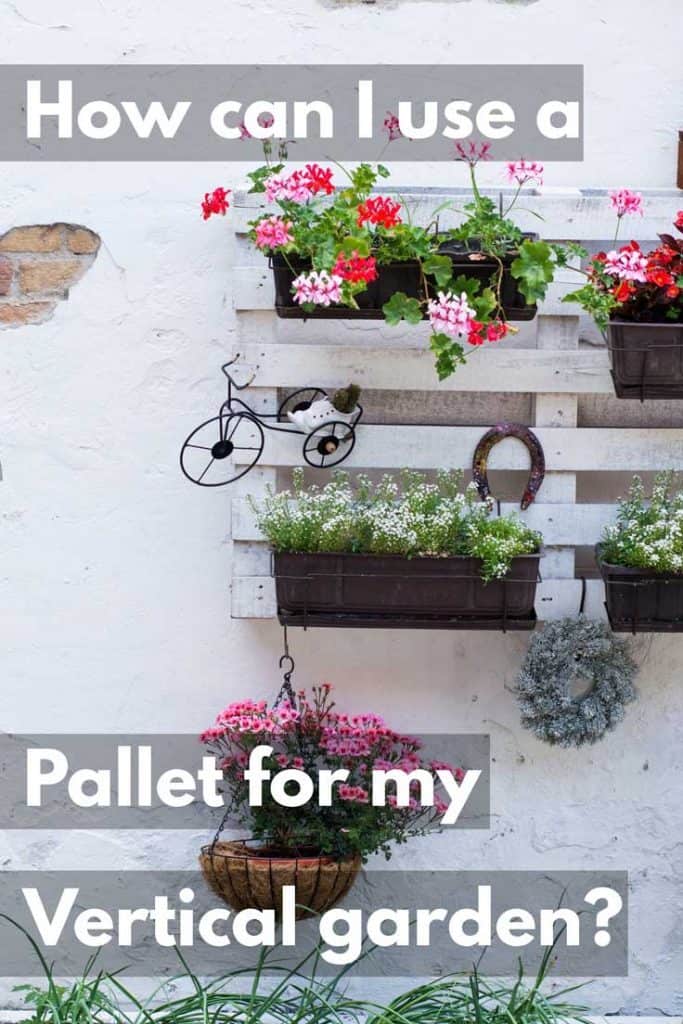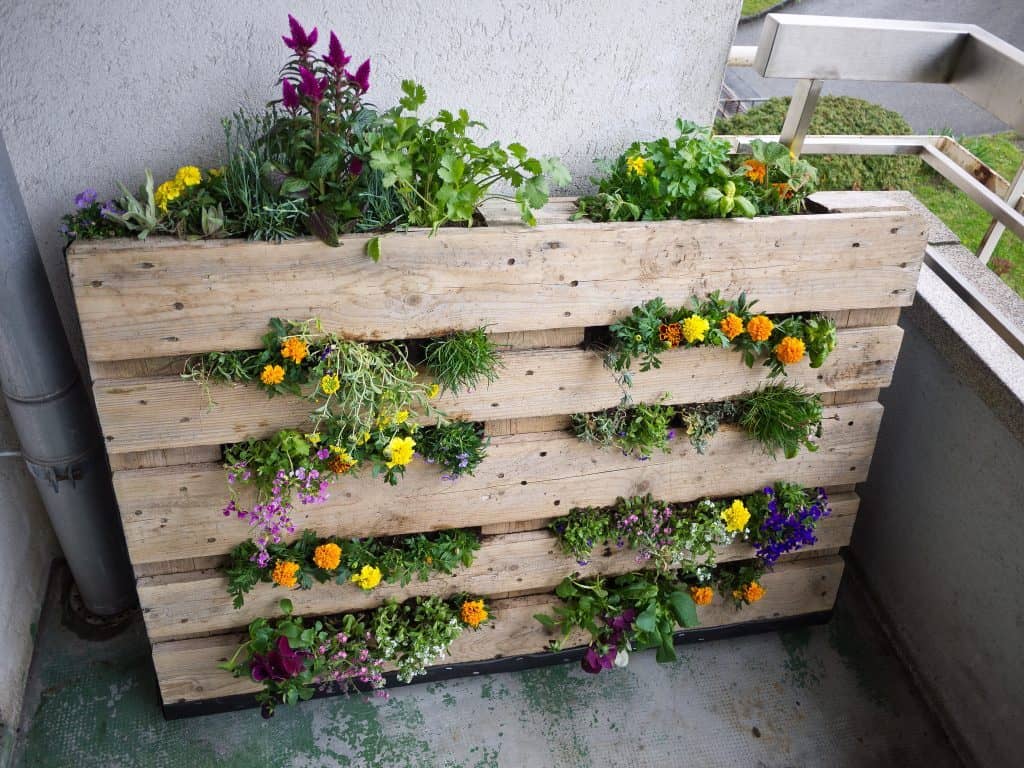If you are wanting to start a garden but have limited space, a pallet based vertical garden is a great option for you! Pallets make inexpensive planters and are easily incorporated into a vertical garden design. After researching this, I think I need to get outside and make something pretty out of my mess of a patio!

There are many different ways you can use a pallet to create an inexpensive but attractive vertical garden. There are the three basic types of vertical gardens you can make using a pallet (or multiple pallets!):
- A leaning pallet garden
- A mounted pallet
garden living wall pallet garden.
If you would like more detailed information on these options, I have included it below. In addition, I have included some other important details I found in my research. Everything you need to know about using a pallet in your vertical garden can be found in this post, just keep on reading!
Are pallets safe to use in gardens?

A pallet is safe as long as it has not been treated with chemicals or used to transport chemicals. Dangerous chemicals can be absorbed into the pallet’s wood and then leach into the soil and plants. Some industrial pallets are treated with Methyl Bromide, a chemical listed as having possible negative effects on reproduction and development.
So, how can you tell which pallets are ok to use? Your pallet should have a label stamped on it. If it doesn’t then assume the worst and do not use it! The label will have several codes on it including the country of origin, the way the wood was treated, and other information.
The method of treatment is what you want to look at. Only pallets labeled “HT,” or heat treated, are totally free of chemical treatments and safe to use. If you see DB, that just means the wood was debarked and will not affect the safety of your pallet.
You do not only have to worry about the wood’s treatment but also what the pallet was used to transport. If you do not know the history of the pallet you might use, then you need to check the wood for stains. If it looks questionable, err on the side of caution and do not use that pallet for planting anything edible!

How to Make a Pallet into a Planter
With a typical wooden pallet, one with multiple slats evenly spaced, you will need the following supplies to create a planter:
- 2 large bags of potting soil
- 1 small roll of weed cloth (or landscape fabric)
- A staple gun & staples
- Sandpaper
Check your pallet for any chipped wood or stray nails. Sand any rough areas so that you won’t hurt yourself during any future use of the pallet. Hammer down or pull any stray nails so that you won’t snag yourself or your weed cloth later on.
The back of your pallet is the part with the largest openings between the slats. During the prep work this is the side you will want to have face up. The weed cloth/landscape fabric will cover the backs and sides.
To cover the backs and sides, pull the weed cloth tight and staple it into place. First cover the bottom rung of the pallet, then cover the entire side facing up (the back of your pallet). Staple more than you think you need to, this is all that is keeping your soil in place, so any holes mean escaping soil!
Flip your pallet over and put it where you plan for it to stay. If you plan to protect your supporting wall with a polyethylene cloth between the planter and the wall, attach the cloth to the back of the planter before you put it in place.
If you are mounting your pallet, now is the time to do so(see below for more instructions on this). Once your pallet is in place, fill the garden with light, good quality potting soil. Transfer your plants into your new pallet planter. Water everything liberally, new plants need a lot of water to root properly.
Making A Leaning Pallet Garden
If you are in a temporary living situation, this is the best idea for you. It will allow you to have a garden without creating any permanent damage to your balcony, patio, or outdoor area.
Once you have the planter created, simply lean it against a wall to support it. I would strongly suggest stapling plastic or a polyethylene cloth to the back of your planter to protect the wall from any moisture.
Mounting (or Hanging) Your Pallet Garden
There are multiple ways to hang your pallet but the one I think is the easiest to use and able to hold the full weight of your watered garden is the French Cleats. They have one package good for up to 100 pounds and another good for up to 200 pounds. I would suggest going with 200 pounds just to be on the safe side.
The package for the French Cleats comes with everything you will need, minus a screwdriver (I would suggest a power screwdriver if you have one). The instructions on the package are very helpful and even link you to a how-to video if you prefer to see it done.
Using the cleats allows you a little “wiggle room” with positioning, all the other options require you to start all over if you do not get it right the first time. The cleats are available at many different hardware stores as well as online.
I again urge you to err on the side of caution and plan fora heavier planter than you expect. It is way better than having the entire thing rip off the wall, or worse bring down a portion of your wall!
Creating A Living Wall Garden using Pallets
To create a living wall garden, you will just line up multiple pallets side by side. Yes, there are other ways to do this, but if you want to use pallets then lining them up will create your living wall.
Mounting your pallets with the French cleats you will be able to hang as many pallets as you want. Keep in mind you will want to properly protect the wall you are using to hang your garden so the water won’t ruin the wall!
What plants work best in a pallet vertical garden?
You will want to use compact plants in your pallet garden.Herbs and greens, especially arugula, are wonderful options as they will work well in this type of planter.
Other planters suggest adding in some edible flowers to add color to your garden. Succulents also work well in a vertical pallet garden because they are compact and require less water than some of the other plants suggested.
In general, you want plants that will either stay within the confines of the pallet or will be able to fall/flow within your planter. What I mean is, a shrub or vine will have a rigid wooden stem that will prevent it from being able to droop at all.
A better option would be flowers or ferns with soft, green stems which will drape down your planter. Plan to place these along the bottom or sides of your planter, otherwise they will cover up your other plants.
Whatever kind of plant you choose to use, make sure the ones within your pallet garden all share the same needs. If you choose plants that need a lot of sun and water for the top level, make sure the amount of water needed is consistent the rest of the way down.
If you choose a fast-growing plant, make sure all the rest are also fast-growing. If you don’t the more aggressive plant will over power the less aggressive and you will not have the variety, you want.
Vertical Gardening 101
In case you're new to vertical gardening, here's a quick recap. It applies to all vertical gardens, whether you use pallets as your base or not.
If you want to have a vertical garden, then there are a few things you need to know to get you started. First, a vertical garden is nothing more than a “regular” garden that utilizes vertical space to grow plants.
Gardeners say that a vertical garden is easier to maintain and, if you plant crops, easier to harvest. They do warn that there are some limitations gardeners need to be aware of.
You need to make sure you match your plant’s sun needs to the area you will plant them in. The further down your plants are in your garden, the less direct sun they will get during the day.
Just because you can build a garden taller than you stand, doesn’t mean you should! You should keep your garden only as high as you can reach. This helps make maintenance easier and saves you difficulty when planting and harvesting.
Make sure the wall you are using to support your garden is able to support the amount of moisture your garden will produce. Many gardeners suggest using a polyethylene cloth as a vapor barrier along the back of your garden to help contain the moisture.
You will always water your garden starting at the top and working your way down. Keep in mind the water will most likely trickle down the pallet so the higher plants will need more water than the lower ones.
And last - but not least - keep on reading other posts in this post. Here are few you might find interesting:
- Which Soil Is Best For Vertical Gardens?
- How to Get the Best Vertical Garden Watering System
- Do Vertical Gardens Damage Walls? (And How to Avoid That)
Have You Tried A Pallet-based Vertical garden?
Tell us what you found helpful when you made your garden! Did you find certain plants worked better when you used a pallet? What tips can you give others about this kind of garden?
We look forward to learning what works, and didn’t work, for you!
